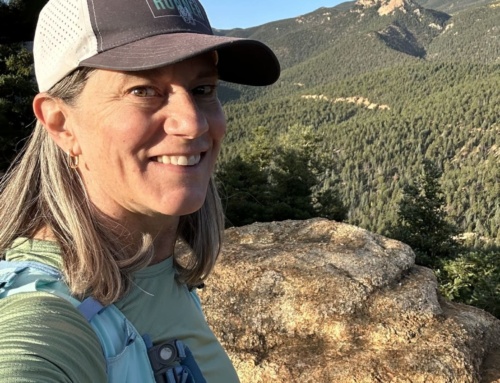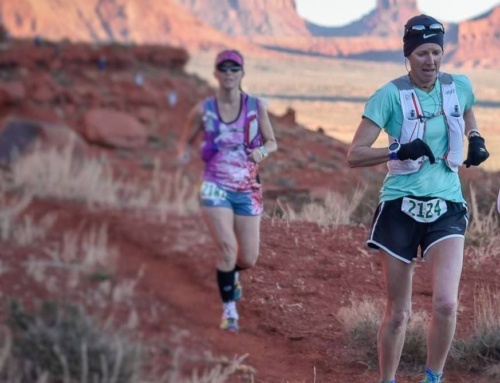
Kimberly at mile 23, about to see her family and on her way to the finish line.
Kimberly Versak didn’t just run the Philadelphia Marathon last weekend. Despite every cell in her body protesting, Kimberly set aside her fears of failure and nailed those 26.2 miles to the wall..
“My secret A goal was a Boston Qualifier (BQ),” she says, ” I achieved it, even though I used a litany of excuses as to why it wasn’t realistic: a full time job, a 2-hour (roundtrip) commute to work, 4 children, a husband who doesn’t like when I’m out of the house for long periods on the weekends, my injury-prone body, etc… But that podcast. That podcast about fear and fear of failure with the mental skills coach. I listened to it twice. You talked how at some point you need to just put it out there. Try. So when I lined up at the starting line, I thought, ‘Let’s try. Let’s run 8:45’s as long as you can and then speed it up to 8:30s. That should give you a 3:52/53 or even a 3:50. That’s your 45-year-old BQ.'”
Kimberly, who was in the #FindYourStrong Marathon Challenge, ran 3:40:33 for a 15-minute personal best: a BQ for her current age group (40-44) and her 2017 age group (45-49) in 2017, the year she’ll run it.
You don’t have to be in the realm, physically or mentally, of a BQ to run your best marathon yet.
Here are Kimberly’s eight keys that will work for anybody taking on 26.2 and wanting their absolute best race.
ONE: I went out slow. In fact, my first two miles were my slowest.
TWO: I studied the course. Miles 11 – 25 were all along a river and out and back. I had read blog reports and studied the race map and knew that the stretch would be painful. I was prepared: I had my music geared up and ready to go once I hit the river.

A well-loved training plan.
THREE: I trusted the training. Unlike previous plans where I blew off the speedwork, I actually did the tempo runs (though I definitely took breaks during some of those miles). The only tweak of the plan was the days when we were supposed to run three days in a row (Thursday, Friday, Saturday). My injury-prone body balked at that. So I skipped the Friday run. Thanks to #FindYourStrong Marathon Challenge group, I realized I COULD set my alarm for dark o’clock and get it done. I began to crave my dark early morning runs. I hated going to work without that run. I strength trained at lunch. (see next point).
FOUR: I cross trained like it was my job. At the gym at my work, there are strength-training classes offered twice a week. They were perfect for me – lots of squats, quad, hip work, and I really focused on activating my glutes. I felt my glutes working working working during the run. When my ITB strained or my hips started to ache, I focused on activating those glutes, and guess what? This was my first marathon where I could actually bend my knee after the race. I also took a yoga class once a week.
FIVE: I carb loaded. I am sure I showed up on the starting line 3-5 pounds heavier than normal, but I was determined not to stress about it. (I wore black instead of pink on top as it’s “slimming.”) I started carb loading on Thursday. I know my stomach is sensitive so I stuck to white bread and white pasta and white rice and white potatoes. I told myself, there will be plenty of time post-race for high protein and more Paleo eating. Pre-race dinner was steak and baked potato; this was my dinner before all my long training runs, so I stuck with it for my pre-race meal.
I drank lots of Nuun and water during the day, even though it meant more stops during the car drive. The morning of race, I woke at 4:45 and choked down another large bagel with more Nuun and a cup of coffee.

No stopping until she crossed the finish line.
SIX: I managed my bathroom issues. I took a fiber supplement five days before—an idea I got from Yo Momma Runs—to encourage a gentle clean-out and ate bland white diet three days before the race. It worked. I didn’t use the porta loo at all during the race, not even when I arrived at the starting line way too late due to the long security lines. And I felt fine.
SEVEN: I rolled with the unexpected. Uber, my preferred method of race day transportation, announced a 3.5-times rate increase and a 16-minute wait. What?! I panicked and then chose my backup plan of getting to the race by subway. It worked well and I met some other runners with whom I bonded during the LONG security lanes.
Speaking of security lines, I remember other marathoners talking about giving yourself more time than you think you need. How right they were, I thought ruefully as I arrived at the lines at 6:22 a.m. for a 7:10 a.m. race. When the clock ticked over to 6:44 and we’d only moved about 30 people, I latched onto the guy in front of me whose friend told him about a security point on the other side of the barricades that apparently was open and free. We led a breakaway group of about 30 anxious runners to find that barricade, repeating anxiously, “22nd and Penn… 22nd and Penn” like some magical gate was going to open. Five-minute jog later, we found our entry point and were high-fiving each other like we’d won the lottery. (Note to self: At big races, don’t be a sheep and automatically line up where everyone else is. sometimes there are other options available…)
EIGHT: I stayed mentally strong. I dug deep. I ate pain like candy. I ate hills for breakfast. I said, “Kimberly is stronger than this. Kimberly has this.” Or “I get to run today.” “I’m so lucky”. “I feel good. My legs, they’re so strong today.” I practiced reframing my negative thoughts—something that made me roll my eyes during mental skills podcast: “Ouch, my feet hurt, but my glutes, they’re really firing.” (And yes, happy to report the reframing worked.)
I practiced two AMR favorite: “Stay in the mile. Stay in the mile. Stay in the mile.” and maybe my most important one, “ I didn’t work this hard to get here to give it all away now.” This “working hard” referred to both the first 20 miles of the marathon AND the past 18 weeks of training.
This is perhaps my most important mantra because I’ve been known to cast away my race goals like an old shirt in the later miles of race. When the tough get going, I start downsizing. Saying, well I’d be happy to squeak in under 4. Actually, I’d happy with a 4:08 and this is a tough course, and it’s windy. And I have bathroom issues too, oh screw it I just want to finish…
Over the 18 weeks of training, I practiced the mental toughness that I always knew I had to do, but kind of avoided. Until I listened to lots and lots of AMR podcasts. And read lots of and lots of race reports from the #FindYourStrong Marathon Challenge.
I had you all with me. And I didn’t want to let you—or myself—down.
YOUR TURN: What are your keys for a strong marathon?






Wow. Kim’s keys are really motovational, true and sound attainable. The mental coach podcast struck a chord with me as well…I listened to it during a training run for my most recent marathon and it really helped me structure my plans. Along with that podcast, I followed the TLAM own it plan. I ended up completing a half marathon (PR!) in the beginning of October and the Cape Cod marathon at the end of the month. Although it was not a PR, the second half was a challenging, hilly race. I felt strong and was rewarded with a negative split!
Similarly to Kim, I felt that many things that had been missing or misfiring for me in the past really fell into place. My fueling strategy, prerace eating and mental strategies were the most successful of the previous three marathons I’ve run. Which leads me to wonder…..what could I accomplish with these same strategies on a flatter, faster course? ;-)
Wow, what a great read. Nothing new on race day-right on sista. Thanks Kimberly!
As for myself and the marathon, I’ve always respected the training plan. 16 week plan? Give yourself 18 or 20 weeks in case of life and you need time to repeat a week. Respect the plan. Plan says run, I run. Plan says rest, I rest. I give myself a little leeway to flip around days or even training weeks, but if you do the plan, you will do the race.
This is really key for me. I went out there with a goal Sunday. I let my negative voice win as the gel station at 10 was out and my mind started freaking out about “What is the next one is out???” It transferred into the pain in my quads. All this is a good reminder that I really need a better cross training plan and a better battle for my mental strength. Congrats on the qualifier!!!
You nailed it. I have nothing to add to this awesome list! Great job!
Damn it…I’m crying AGAIN over this race recap. SOOOOO proud of you!
Woot!
This is so perfect and exactly what I needed today. Thank you so much for sharing! I am printing this post and putting it in my Go Get It Journal.
Congrats Kimberly! The first three keys are something I’ve always tried to remember. It’s number four that usually gets kicked to the curb. This is a great list and inspirational and attainable.
First off congrats Kimberly, great job! I too ran Philly 26.2. For me there were three big keys to my finish: first was slow it down. My goal was simple: finish upright. My Garmin didn’t always register right the first half due to city blocks so I purposefully made myself slow down every song. Second I took a cliff block every mile after 3, 2 Bevita cookies at mile 10, and a banana at 16. What a huge difference. Finally my ace in the hole was my running partner joining me at mile 20. I didn’t finish last year due to dehydration and the mental confusion that comes with it. My “wing woman” saved some good stories, made a custom playlist, and paced me that I actually passed a ton of people those last 6.2.
Congratulations!
Malinda, the slower 1/2 of @TwinsRun, failed her 9th attempt to BQ at Philly. She is not ready to give up her goal and already registered for her 10th attempt on March 12! :-)